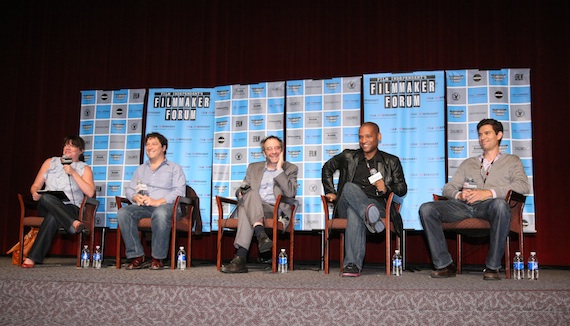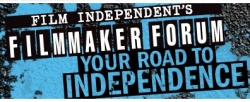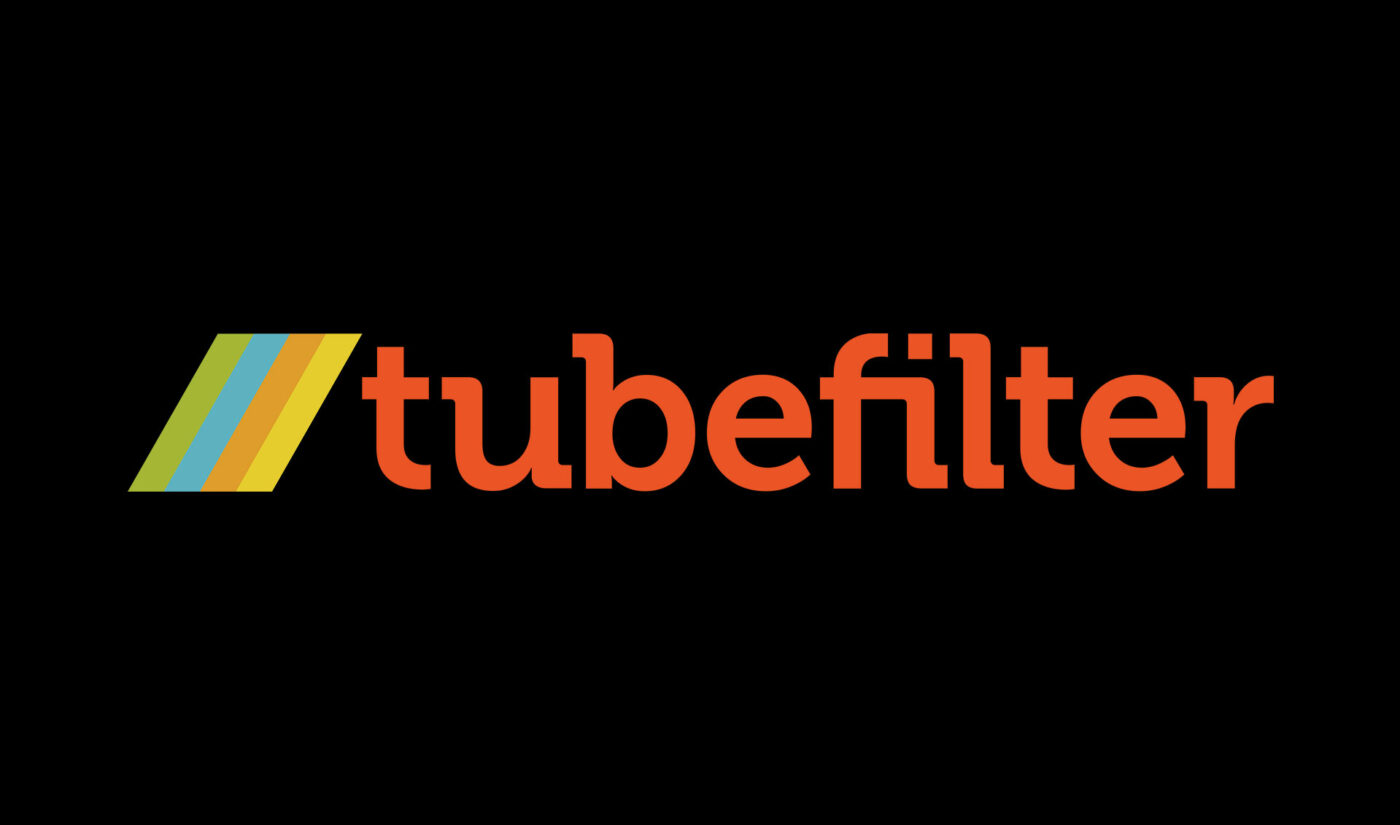 Ami Armstrong, Jonathan Stern, David Worthen, Scott Sanders and Mike Farah (Photo by: Alexandra Wyman/Wire Image)
Ami Armstrong, Jonathan Stern, David Worthen, Scott Sanders and Mike Farah (Photo by: Alexandra Wyman/Wire Image)
I’ve been to a ton of panels on the Future of Web Series Production, but most of them take place at conferences like Digital Hollywood, which are dedicated to new media. On Sunday, October 11th, independent film organization Film Independent (FIND) got into the act at the FIND Filmmaker Forum with a panel entitled “Going Online: New Stories for New Media.”
In the midst of a weekend filled with sessions covering the art and business of indie film, the panel gave the producers, writers and directors in attendance a look into the possibilities the smallest screen has to offer. The session was specifically focused on creating content for the web, as opposed to using the web as a means of distribution for feature films. Producer Ami Armstrong (Mr. Nice) moderated, and panelists included Jonathan Stern (Producer, Centrifugal Films), David Worthen (Sr. Vice President, Fox Digital Studio), Scott Sanders (Director, Black Dynamite) and Mike Farah (Producer, Funny or Die).

Subscribe to get the latest creator news
 Armstrong kicked off the session with the question, “Who’s actually watching all these videos online?” The general consensus was that while so far the young male demo has dominated, there is an emerging female audience for web content. Panelists cited breakout shows In the Motherhood, an MSN online original that was picked up for broadcast television by ABC, and Lisa Kudrow’s Web Therapy.
Armstrong kicked off the session with the question, “Who’s actually watching all these videos online?” The general consensus was that while so far the young male demo has dominated, there is an emerging female audience for web content. Panelists cited breakout shows In the Motherhood, an MSN online original that was picked up for broadcast television by ABC, and Lisa Kudrow’s Web Therapy.
Stern, producer of Wainy Days, Children’s Hospital and Hot Sluts, says that he is starting to put together a few shows created by women over 30. “It’s almost easier to get a female-driven show going right now,” says Stern, “because the sponsors are looking for it. The Axe’s of the world already have a foothold in that space.”
Worthen adds, “What is now happening in the creative process is that some of the female writers have petitioned me because they want things that aren’t ‘Smacking Your Balls On A Skateboard.'”
To which Stern immediately responds, “Where can I get that skateboard?”
(***Note to future panelists: bringing a sense of humor to your panel will forever earn you the gratitude of your audience.)
Entities like the CW have done a lot to develop a younger female audience, and companies such as Alloy Entertainment, part of Alloy Media + Marketing, have shown that they are interested in capitalizing on that online. Teen.com TV features both web shows that expand Alloy properties such as the young adult novel series Private, as well as originals like Haute & Bothered, which Armstrong produced.
Just as with independent film, before you can find the audience for your projects, you need to find the money to produce them (though I know several marketing execs who might disagree). Brand sponsorship is the current flavor of the month – witness the huge outpouring of love at the recent My Damn Channel premiere for the IKEA-sponsored Easy to Assemble. But Worthen reminded the audience about “the Dr. Horrible model,” where users pay a specific amount per download via services like iTunes. Others have tried a hybrid approach, releasing content for free for a limited window to build buzz before going the transactional route.
Content aggregator Funny or Die is supported by advertising on the site as a whole, as opposed to individual sponsorship for specific videos. Several times throughout the panel, Farah reinforced that FOD does not pay for nor purchase content. The site, which has an in-house production team, does try to help out the groups they’ve formed relationships with whenever they can, letting them use their equipment or throwing a couple hundred bucks their way to secure a location. Ultimately, though, for creators who showcase their work on the site, the rewards are more about being recognized for their efforts than being paid for them.
Farah tells the story of the comedy group Honor Student. Not a lot of people were watching their videos, but as Farah describes it, “The right people were watching.” Funny or Die started making pieces with them, Adam McKay and Will Ferrell loved what they did and eventually some of the group’s material made its way onto FOD’s HBO program. Says Farah, “We can’t offer $100 bucks per video, but we can offer that.”
One of the reasons that FOD doesn’t pay for content is because they feature so many celebrities in their videos. “Everyone has an agent, whether it’s Will or a kid from UCB,” jokes Farah. “If we waited to make a deal for every video we did, we wouldn’t have a site. It would take forever to make our videos.”
This is a predicament with which independent filmmakers are heartbreakingly familiar. There are dozens of stories about celebrated Sundance underdogs that took years of blood, sweat and tears to bring to the big screen due to the eternal process of getting stars attached in order to secure financing. All of the panelists encouraged the audience not to wait, and to take advantage of the low barrier of entry offered by the Internet.
Says Armstrong, “There is currency and compensation in being able to share your work and demonstrating what you’re able to do.” Go out and make the things you are passionate about, and that will lead you to the things you can make money at.
 Of course, even when you have a hit series, making money is never simple. Witness the saga of cult-favorite Wainy Days, an official honoree for Best Comedy Series for the 2009 Webby Awards, and winner of the 2008 Webby Awards’ Best Comedy Series as well as the 2009 Streamy Awards’ Best Guest Appearance for Paul Rudd. Stern gave the audience the inside skinny on the ups and downs of getting the series out into the world.
Of course, even when you have a hit series, making money is never simple. Witness the saga of cult-favorite Wainy Days, an official honoree for Best Comedy Series for the 2009 Webby Awards, and winner of the 2008 Webby Awards’ Best Comedy Series as well as the 2009 Streamy Awards’ Best Guest Appearance for Paul Rudd. Stern gave the audience the inside skinny on the ups and downs of getting the series out into the world.
My Damn Channel provided the production budget for Wainy Days. As a result of the series’ popularity, there have been a number of requests to put the episodes out on DVD. However, Wainy Days was shot under the old SAG contract, which stipulated that if they went forward with a DVD, they’d have to pay the actors upfront as though they were doing a feature film. The price tag? Oh, a mere $100,000 or so. Big bucks in the web universe. Wainy Days petitioned SAG to switch over to the new contract, which is based on percentages and is therefore much more affordable, however, the union wouldn’t budge.
Armstrong asked Stern if My Damn Channel had been interested in forking over the $100,000 to cover the costs of the DVD, and Stern said that he didn’t think they’d make enough in sales to cover the investment. He says, “We’d have to sell 20,000-25,000 DVDs. In the independent world, 5000 is a hit.”
SAG sounds like the bad guy in this episode, but Armstrong offered some insight on the Guild’s position. “There’s a lot of paranoia about people being taken advantage of,” she explains. “With magazines folding, brands still have those budgets to spend on ads…and they want to put them on the web. The Guilds want to make sure that if people are getting paid, their members are getting part of that.”
She adds, “It’s a high class problem to say, ‘I now have the money to make something, and now I have to jump through the hoops of the Guild.’ Things changed when digital tools became available and people could make low budget films. SAG responded by coming up with low budget agreements, which they are still adjusting.”
Hopefully in the future, the Guilds will take this lesson from their adventures with independent film and continue to evolve their contracts for web video. As the industry continues to grow and morph, ideally the Guilds will find that sweet contract spot that allows for the pursuing of additional revenue streams while at the same time fairly compensating professional artists.
Over at Fox Digital Studios, crossing the streams (Ghost Busters, anyone?) is now a priority. Worthen says, “We look at the idea and ask if can we have a run on iTunes. FX? Can we get a shout back from Fox Broadcasting Company? Is it an idea that Fox 21 studios may want to produce into a TV show? What are the home entertainment possibilities for VOD, transactional, and traditional DVD?”
It wasn’t always this way for Worthen and his colleagues. He laughs, “Originally, people used to come through and ask ‘What the F is going on here?’ Now, from the very top of this huge conglomerate has come a mandate to make digital work. A homerun for us does well on the web, but also can occupy a number of other windows of opportunities that this conglomerate provides.”
There are still a few dots to connect between making a living as a web content creator and hitting that homerun. Producers Armstrong and Stern freely admitted that their web projects don’t yet pay all the bills, and that they are still – by necessity – active in all parts of the entertainment business, including traditional television. Sometimes their web ventures function as back-door pilots, sometimes they are creative experiments.
Says Farah, “Old Media isn’t going to work forever, but it isn’t gone and broken. It’s breaking down into new things. We’re in this adolescence, so that’s the opportunity to make the things you couldn’t make before, and at the same time, to be developing the things you can’t make without a brand or larger company being involved.”
 Tamara Krinsky is an actress, journalist, new media producer and regular contributor to Tubefilter News. She has appeared in web series such as Back on Topps and The Shaman, along with a variety of film, TV & theater projects. As a reporter, she focuses on entertainment, science and tech news. She hosted the weekly tech show THE SPOTLIGHT for TomsGuide.com, was a correspondent for PBS’s WIRED SCIENCE, and was a Webby honoree for the independent film series AT THE FEST, which she produced and hosted. She is currently the Associate Editor of DOCUMENTARY Magazine. In addition to her adventures on camera, Krinsky became intimately acquainted with the business of web video while working for 2.5 years at the entertainment marketing firm Crew Creative, where she strategized and produced online content for clients including the Discovery Channel, TLC, Warner Independent Pictures, Picture People and Overture Films.
Tamara Krinsky is an actress, journalist, new media producer and regular contributor to Tubefilter News. She has appeared in web series such as Back on Topps and The Shaman, along with a variety of film, TV & theater projects. As a reporter, she focuses on entertainment, science and tech news. She hosted the weekly tech show THE SPOTLIGHT for TomsGuide.com, was a correspondent for PBS’s WIRED SCIENCE, and was a Webby honoree for the independent film series AT THE FEST, which she produced and hosted. She is currently the Associate Editor of DOCUMENTARY Magazine. In addition to her adventures on camera, Krinsky became intimately acquainted with the business of web video while working for 2.5 years at the entertainment marketing firm Crew Creative, where she strategized and produced online content for clients including the Discovery Channel, TLC, Warner Independent Pictures, Picture People and Overture Films.








